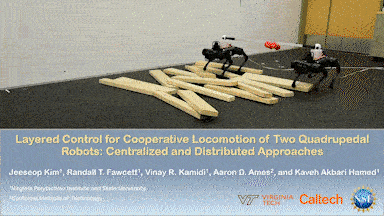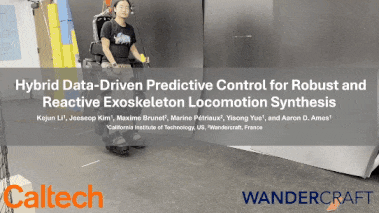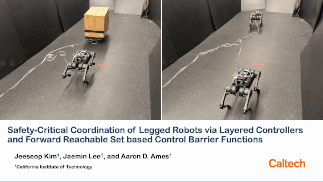Overview
Cooperative Robotics  Reasoning Uncertainty/Safety
Reasoning Uncertainty/Safety 
Safety Critical Control  Quadrupedal Robot/Humanoid
Quadrupedal Robot/Humanoid 
Project: Cooperative Robotics
Future cities will feature complex, interconnected networks of collaborative robots working cooperatively with each other and humans to support our societies. Although we've seen remarkable theoretical and technological advances in distributed controllers for motion control of multi-agent robotic systems, current approaches still fall short in addressing the collaborative locomotion problem for legged robots in human spaces. My research focuses on developing novel frameworks that bridge this gap, enabling legged robots to navigate urban environments with the adaptability and social awareness necessary to become true partners in our future cities — not just technological additions, but integrated elements of urban ecosystems working seamlessly alongside people.
Project: Reasoning Uncertainty/Safety and Decision Making
Uncertainty and safety represent fundamental challenges when deploying robots in human-centered environments. While both are critical considerations that require attention, they involve numerous complex parameters that are difficult to model comprehensively. To address these challenges, this research thread focuses on leveraging various data-driven approaches, including advanced learning frameworks, to effectively manage inevitable uncertainties and ensure robust safety guarantees during system deployment in real-world scenarios.
Project: Safety Critical Control
Ensuring the safety of robot locomotion across diverse operating conditions is essential for deploying systems in human-centered environments. While numerous studies have addressed motion planning and collision avoidance for various platforms, legged robots have received comparatively less attention in this domain. Furthermore, conventional safety-critical controllers typically rely on measuring distance from unsafe states, which results in robots initiating evasive maneuvers only when hazards are in close proximity — a potentially problematic limitation for dynamic locomotion tasks. This research explores more anticipatory and robust safety frameworks specifically designed for legged robotic systems.
Project: Legged Robots - Humanoids and Quadrupedal robots
More than half of Earth's terrain is inaccessible to wheeled vehicles — motivating the development of legged robots to navigate these challenging environments and expand robotic capabilities in the real world. However, legged robots present unique challenges: they are inherently unstable systems that operate through complex hybrid dynamics involving discrete footfall events and continuous motion phases. Furthermore, these systems are characterized by high-dimensional state spaces, underactuation, and nonlinear behaviors that significantly complicate the design of effective control algorithms and motion planning strategies. Our vision is to create robust locomotion frameworks that enable legged systems to successfully operate in complex, uncertain terrain while maintaining stability and adapting to unexpected conditions — ultimately bringing capable robotic assistance to previously inaccessible environments.